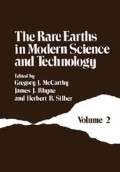Abstract
This paper shows the influence of ionicity on the eσ and eπ antibonding effects in some Eu3+ doped compounds: KY3F10, LaCl3 and YMO4 (M=P,As,V).
In the ligand field approximation, the eσ and eπ parameters are determined for each kind of ligands, using the angular overlap model of Jørgensen. The obtained eσ and eπ must not only fit the crystal field energy values expressed in terms of experimental B mn (deduced from fluorescence spectra) but also each B mn .
It is observed that the importance of the π effects (compared to the σ effects) increases with ionicity for all the Eu3+ doped compounds whatever the ligand may be. Moreover, the contribution of the π effects increases appreciably as Eu3+ is replaced by Er3+.
Access this chapter
Tax calculation will be finalised at checkout
Purchases are for personal use only
Preview
Unable to display preview. Download preview PDF.
References
C.E. Schäffer, C.K. Jørgensen, The Angular Overlap Model, Mol. Phys. 9, 401 (1965).
D. Küse, C.K. Jørgensen, Angular Overlap Treatment of erbium (III) in xenotime and yttrium Orthovanadate, Chem. Phys. Letters 1, 314 (1967).
M.R. Kibler, Comparison between the Point-charge Electrostatic Model and the Angular Overlap Model: Int. J. Quantum Chem. 9, 403 (1975).
M.R. Kibler, G. Grenet and R. Chatterjee, On the Interpretation of Crystal-field Parameters with additive Models, J. of Luminescence 18/19, 609 (1979).
W. Urland, The Interpretation of the Crystal-field Parameters for fn Electron Systems by the Angular overlap Model. Chem. Phys. Letters 53, 2, 296 (1978).
J. Glerup, O. Monsted, C.E. Schäffer, Nonadditive and additive Ligand Fields, Inorg. Chem. 15, 6, 1399 (1976).
J. Josephsen, C.E. Schaffer, The Position of 2,2′-Bypyridine and 1,10-Phenanthroline in the Spectrochemical Series, Acta Chem. Scandin., A31, 813 (1977).
D. Brown, B. Whittaker, N. Edelstein, Spectral Properties of the Octahedral (NEt4)2 PaF6, Inorg. Chem. 13, 1805 (1974).
Author information
Authors and Affiliations
Editor information
Editors and Affiliations
Rights and permissions
Copyright information
© 1980 Plenum Press, New York
About this chapter
Cite this chapter
Gaume, F., Linarès, C., Louat, A., Blanchard, M. (1980). The Trend of the Eu3+ - Ligand Bonding in Covalent and Ionic Rare-Earth Compounds. In: McCarthy, G.J., Rhyne, J.J., Silber, H.B. (eds) The Rare Earths in Modern Science and Technology. Springer, Boston, MA. https://doi.org/10.1007/978-1-4613-3054-7_14
Download citation
DOI: https://doi.org/10.1007/978-1-4613-3054-7_14
Publisher Name: Springer, Boston, MA
Print ISBN: 978-1-4613-3056-1
Online ISBN: 978-1-4613-3054-7
eBook Packages: Springer Book Archive

